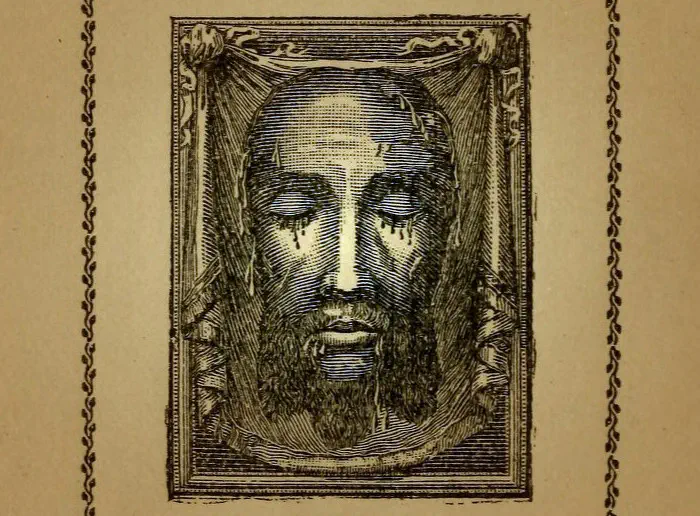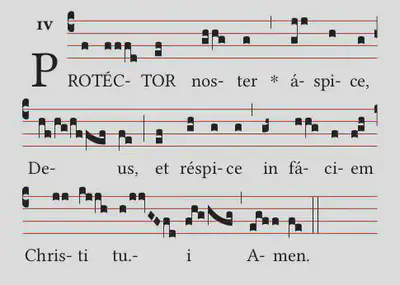Chaplet of the Holy Face

(Here is another variation on the chaplet for future reference)
I received a curious request. How would one go about chanting the Chaplet of the Holy Face.
My name being Veronica, I have an innate attraction to the Holy Face devotion. Last year I was given a pair of leaflets from the Holy Face group in Albury on the border of NSW and Victoria here in Australia. This group is actively promoting the chaplet. Their leaflets elaborate on the chaplet with extra prayers from Sister Marie de Saint-Pierre.
Latin translations
Of course, someone has already had a go at this over at Praying Latin. All the basic prayers are either commonly prayed, so already in Latin, or from the Bible, so also already in Latin.
(Numbers 10:35)
Arise, O Lord, and let thy enemies be scattered, and let them that hate thee, flee from before thy face.
Surge Dómine et dissipéntur inimíci tui et fúgiant qui odérunt te a fácie tua.
(Psalm 83:9)
O God, our Protector, look down upon us and cast Thine eyes upon the Face of Thy Christ!
Protéctor noster, áspice, Deus, et réspice in fáciem Christi tui.
Arrangement
The basic outline, as I can understand it, is:
- Deus in adjutórium meum inténde
- Dómine ad adjuvándam me festína.
- Glória Patri … allelúia.
- Then 5 sets of (Jesu miserére, Surge Dómine x6, Glória Patri)
- Then last set (Jesu miserére, Surge Dómine x3, Glória Patri)
- Finally “Protéctor noster…” being the first part of the Introit for the 14th Sunday after Pentecost.
Most webpages have O mi Jesu, misericordia. I’m not sure, but in Latin litanies and other prayers, we usually say “miserere” which is a one word form of “have mercy”. In English, when we say, ‘Jesus, mercy!’ it’s more short for ‘Jesus, have mercy on us’ - so it’s not so much using ‘mercy’ as a noun, which would be ‘misericordia’ in Latin, but as an imperative verb, which would be ‘miserere’ in Latin. So that’s why I’m going with Jesu, miserere.
Second issue: most webpages put the ‘My Jesus, mercy’ directly with the ‘Glory be to the Father’, followed by the six ‘Arise O Lord’s. Usually in liturgical prayers you find the ‘Gloria Patri’ at the end of a Psalm. While you don’t have psalms here, the repetition of ‘Surge Domine …’ forms something of a psalm-like thing. I’m going with a more Rosary-like arrangement of ‘My Jesus, mercy’, 6x ‘Arise O Lord’, ‘Gloria Patri’. A close reading of Fr Janvier’s book on the devotion allows for this interpretation. I’ve pasted the relevant description at the end of the page.
Tunes
I have the Latin for all those prayers. They could all be sung to a psalm tone. Maybe even change psalm tones for each set.
Protector Nos is an Introit for the 14th Sunday after Pentecost. Introits are moderately elaborate chants. Some say that in Medieval times the congregation would join in singing these at Mass. Nowadays most sung Latin Masses reserve singing these to a choir.

Extra Prayers
The remaining extra prayers might be easier to translate from the French into Latin, as those two languages are a little closer.
The main prayer is the Golden Arrow or Flèche d’Or:
Qu’à jamais soit loué, béni, aimé, adoré, glorifié le très Saint, très Sacré, très Adorable, très Inconnu, très Inexprimable Nom de Dieu, au ciel, sur la terre et dans les enfers, par toutes les créatures sorties des mains de Dieu et par Notre-Seigneur Jésus-Christ au très Saint Sacrement de l’autel. Ainsi soit-il.
or in English:
May the most holy, most sacred, most adorable, most incomprehensible and unutterable Name of God be always praised, blessed, loved, adored and glorified in Heaven, on earth, and under the earth, by all the creatures of God, and by the Sacred Heart of Our Lord Jesus Christ, in the Most Holy Sacrament of the Altar. Amen.
in Italiano (Freccia d’oro):
Sia sempre lodato, benedetto, amato, adorato, e glorificato, il santissimo, il sacratissimo, l’adorabilissimo, l’incomprensibile ed inesprimibile Nome di Dio in cielo, sulla terra e negli inferni, da tutte le creature uscite dalle mani di Dio, per il Sacro Cuore di Nostro Signore Gesù Cristo nel Santissimo Sacramento dell’Altare. Amen.
The Sources
Here is an extract about the Chaplet taken from Sister Saint-Pierre and the work of reparation : a brief history by the Very Rev P Janvier
The purpose of the Crown or Chaplet of the Holy Face is to honor the five Wounds of our Lord Jesus Christ and to ask of God the triumph of his Holy Church.
This Chaplet is composed of a cross and thirty-nine beads ; of these six are large beads and thirty-three small ones ; to this Chaplet is attached a medal of the Holy Face. It would be well to recite it daily in order to obtain from God, by the Face of his well-beloved Son, the triumph of our holy mother, the Catholic Church. On the cross, which reminds us of the mystery of our Redemption, we begin the Chaplet by saying the words : “Deus in adjutorium meum intende. Domine ad adjuvandum me festina” (“Incline unto my aid, O God ; O Lord, make haste to help me”), followed by the Gloria Patri etc.
The thirty-three small beads represent the thirty-three years of the mortal life of our Divine Lord. The first thirty beads recall to us the thirty years of his hidden life, and are divided into five parts of six beads each, in honor of the five senses of touch, hearing, sight, smell, and taste of Jesus; and, as they were situated principally in his Holy Face, to make reparation for all the sufferings which our Lord has endured in his Face through each one of these senses.
The six beads are preceded by a large bead, followed by a Gloria Patri, etc., to recall the sense we wish to honor. The other beads mark the three years of the public life of our Lord, and have for their intention to honor all the Wounds of his Adorable Face. These are also preceded by a large bead, to be followed by a Gloria Patri, etc., for the same intention.
On each large bead is said : “My Jesus, mercy” (100 days’ indulgence). On the small beads is said: “Arise, O Lord, and let thy enemies be scattered, and let those that hate thee fly before thy Face.”
The Gloria Patri, etc., is recited seven times in honor of the seven last words of Jesus upon the Cross and the seven Dolors of the Immaculate Virgin.
The Chaplet is concluded by saying on the medal : “God our protector, look down upon us and cast thine eyes upon the Face of thy Christ.”
(With the approbation of N. J. Perche, Archbishop of New Orleans.)